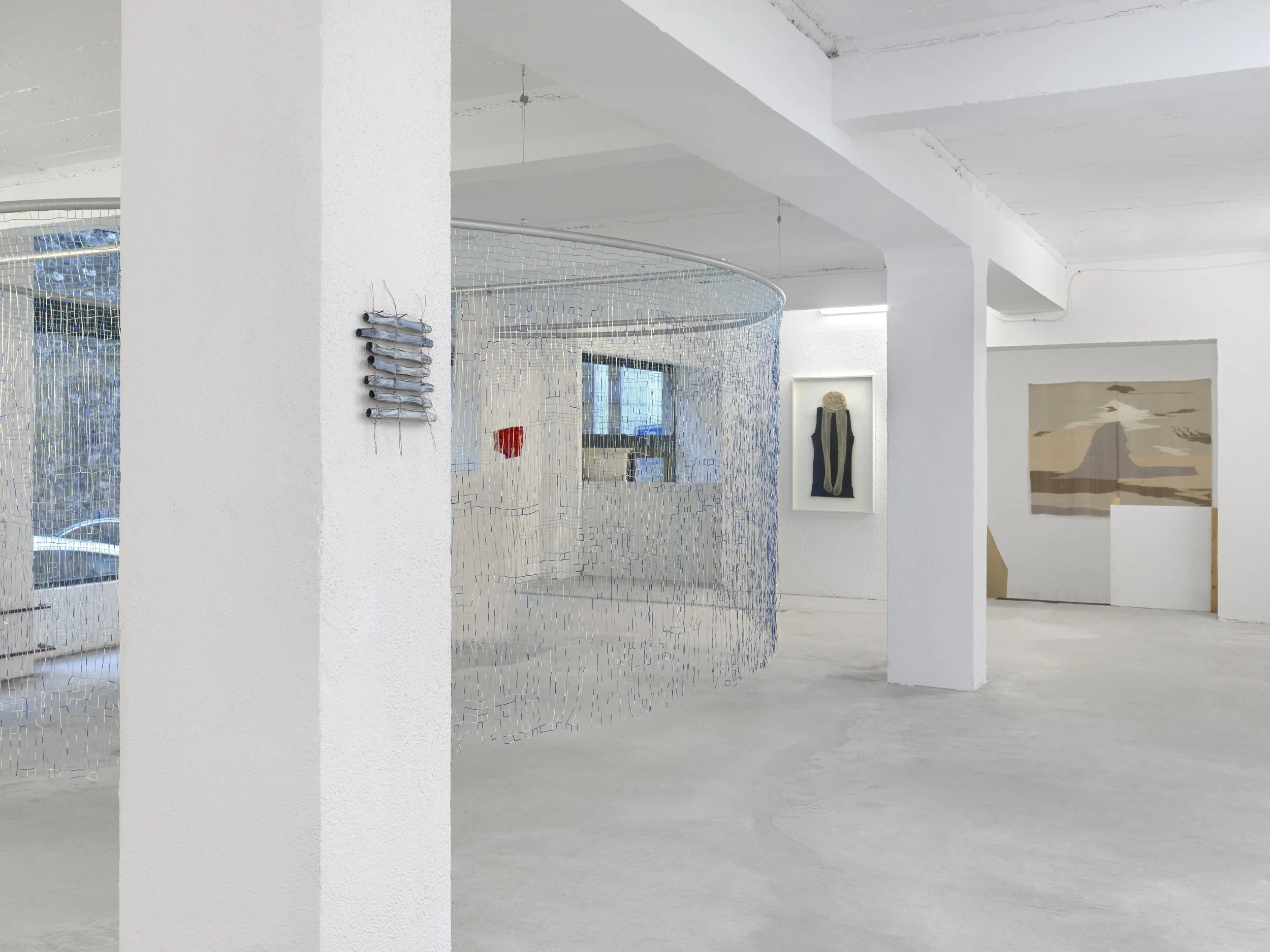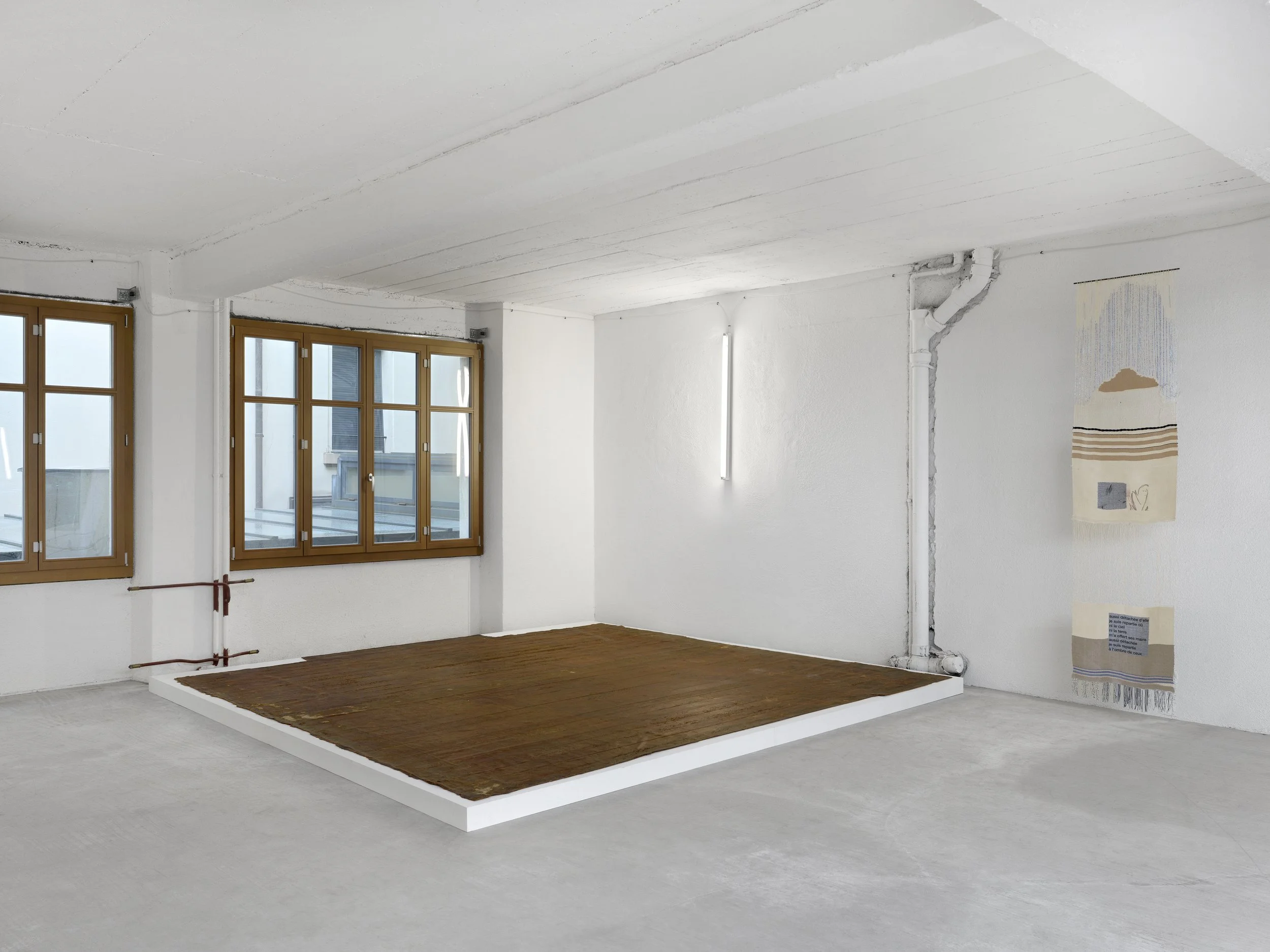for frederic maillard, marie hazard and heidi bucher
I wrote
In the context of the combined exhibition of works by Marie Hazard and Heidi Bucher, Chambres à Air, in Geneva, I wrote the exhibition text as well as a poem (in both English and French).
——— English below
Les doigts glissés
au travail
dans la texture des mots, des moments
j’ai lutté, guetté, arraché la peau
épaisseur généalogique
Le corps a suivi, catégorique et puissant
La peau a subsisté, cueilli
dans sa matérialité spongieuse
Tissu éthéré, déposé sur les possibles
interstices d’évidence
où s’invite, où j’invite le monde
à frapper à la porte de ma coquille
J’ouvre les fenêtres vers un passé
dont je ne garde que les couches
aux mille perles et semblants
mes pieds, seul contact
ont traversé les couloirs de ma mémoire
ont pavé l’espace renouvelé
nouveaux piliers de ma propre architecture
les contours flous du souvenir et du présent
ont créé les chambres aérées, détachées
du temps fugace
à travers ces échappées, un fil
perlé — nacré
miroirs de rideaux, de couches du moi
sur lesquels je compose
la taille de mon âme
Quelle est la composition des murs qui bordent notre âme?
Semblent s’interroger à quelques années - quelques couches temporelles - d’écart, Heidi Bucher et Marie Hazard, dont les corps au travail décèlent les souvenirs dans les interstices de la peau. Le travail des deux artistes se retrouvent à travers de multiples entremêlements où le tissu, composé et composant, déroule ses fils dans les couloirs du souvenir. Les couloirs traversent une maison faite de murs en gaz(e), où ces murs ne sont plus ancrés dans un sol, qui, horizontal, attend qu’on le pave de nos pas incertains. Les chambres de cette maison volent, au gré du vent et frémissent au gré des perles. Elles sont en chrysalide, emplie d’un air nouveau. Ces nouveaux espaces se déplacent, voyagent, s’attachent grâce à deux pieds, piliers et racines, glissés dans des mailles protectrices. Les tiroirs sont ouverts, clairs, honnêtes et désormais nacrés d’une couche de renouveau.
Bucher et Hazard, dans la singularité de leurs approches, proposent une recomposition de la mémoire. Bucher, à travers ses skinnings, arrache les couches du souvenir, du déterminisme, dans un geste intime et politique, investissant des espaces interlopes pour se les réapproprier et traverser leurs murs, eux-mêmes enfermés dans les injonctions et les anciennes vérités. S’invite parfois une couche de nacre, irisée, comme un vernis du présent. Hazard dépose quant à elle les images de la mémoire, personnelle et collective, non seulement sur ses tissages à l’aide de la sublimation mais également de façon plus éthérée, dans l’air qui traverse les perles de ses installations. Elle inscrit ainsi des paysages temporels grâce aux fils, proposant autant de fenêtres vers le réveil des mots et de leurs possibles. Bucher et Hazard se répondent alors pour créer de nouvelles architectures de la pensée, désirées, choisies et solides.
Les matières qui les composent sont déterminantes. Bucher, dans son choix du latex, amène une discussion sur la durabilité de la matière et donc, immanquablement des souvenirs qu’elle porte. La peau du parquet de la maison d’Obermülhe s’effrite, elle aussi, au gré du temps, des personnes qui la rencontrent et la racontent, elle fait apparaitre la gaze, tissu rassembleur, comme pour nous présenter sa structure avant l’envol ultime vers l’oubli. Cette continuité de la matière, Hazard l’interroge par les matériaux qu’elle choisit, ces chambres à air utilisées qu’elle récupère, à qui elle donne une place et qu’elle rassemble par les fils de cuivre. Dansent ainsi les contours flous entre la peau publique et la peau privée, celle dont on se détache et celle que l’on compose. Le temps est transitoire et il s’agit alors d’inscrire l’éphémère dans sa beauté fugace et des fils qu’il dépose derrière lui.
Le corps est interrogé, dans sa force et sa faiblesse, dans sa perméabilité et sa confiance. Au coeur: les gestes. Hazard se tord à la cadence d’Indestructible - son métier à tisser -, porte, tire, glisse et caresse. Bucher applique et arrache puis s’habille. Le corps est au travail et subit ces gestes, il est déterminé dans l’effort et découvre ses limites. Pour autant, il retrouve toujours sa place et pour Bucher, il y avait Borg, son atelier dans une ancienne boucherie à Zurich, lieu de retrait et de protection, dont les murs furent les premiers à être traduits en latex. Une autre coquille essentielle: le vêtement dont elle a d’ailleurs étudié la confection. Les sous-vêtements repris par les deux artistes, l’entre-peau, trônent en revendication
féministe du privé, comme d’autres murs touchant le corps des femmes. Par ces gestes et ces revendications, elles s’inscrivent dans une généalogie en rhizome d’artistes, de femmes qui deviennent les témoins d’un passé choisi et les piliers d’un présent reconstruit.
Bucher et Hazard semblent se rencontrer pour créer un vaisseau, aux ondulations flottantes et à la matérialité gazeuse, où s’agite l’ensemble des souvenirs et des présents pour, finalement, nous faire atterrir dans notre corps, conscient de ce qui le compose et de ses formes uniques mais s’inscrivant dans une totalité solide et heureuse, ancrée dans le présent et sa future mémoire.
Slipping fingers
at work
into the texture of words, of moments
I struggled, watched, tore off the skin
genealogical thickness
The body followed, resolute and powerful
The skin remained, gathered
in its spongy materiality
ethereal fabric, laid over the possible
interstices of evidence
where I invite the world
to knock on the door of my shell
I open the windows to a past
of which I keep only the layers
Of a thousand pearls and semblances
my feet, the only contact
have traversed the corridors of my memory
paved the renewed space
new pillars of my own architecture
the blurred contours of memory and present
have shaped the airy, detached rooms
of elusive time
through these escapes, a thread
beaded - pearlescent
mirrors of curtains, layers of the self
on which I compose
the size of my soul
What is the composition of the walls that border our soul?
This seems to be the question posed, a few years – a few temporal layers – apart, by Heidi Bucher and Marie Hazard, whose working bodies uncover memories in the interstices of the skin.The work of these two artists converges through multiple interweavings, where fabric, both composed and composing, unfurls its threads in the corridors of memory. These corridors traverse a house made of gas (gauze) walls, walls no longer anchored to a ground that, horizontal, waits to be paved by our uncertain steps. The rooms in this house float on the wind and quiver with the pearls. They exist in chrysalis, filled with a new air. These new spaces move, travel, anchored by two feet, pillars and roots, wrapped in protective meshes. The drawers are open, clear, honest, now coated with a pearlescent layer of renewal.
Bucher and Hazard, in the uniqueness of their approaches, offer a recomposition of memory. Bucher, through her skinnings, strips away the layers of memory and determinism in an intimate yet political gesture, reclaiming and traversing spaces laden with constraints, walls themselves trapped by injunctions and old truths. Sometimes, a pearlescent layer appears, iridescent, like a varnish of the present. Hazard, meanwhile, lays images of memory, both personal and collective, not only onto her weavings through sublimation but also more ethereally, into the air that flows through the beads of her installations. She creates temporal landscapes through threads, offering as many windows into the awakening of words and their possibilities. Bucher and Hazard thus respond to each other to create new architectures of thought – desired, chosen, and solid.
The materials that compose them are crucial. Bucher, through her choice of latex, initiates a discussion about the durability of the material and, inevitably, the memories it carries. The skin of the wooden floor in the Obermülhe house also crumbles with time, with the people who encounter and recount it, revealing the gauze—a unifying fabric—as if to show us its structure before the ultimate flight into oblivion. This continuity of material is questioned by Hazard through the materials she selects, such as the repurposed inner tubes she collects, grants a place to, and unites with copper threads. In this way, the blurred contours between public skin and private skin—the one we shed and the one we compose—begin to dance. Time is transient, and the task lies in capturing the ephemeral, embracing its fleeting beauty and the threads it weaves in its wake.
The body is questioned—in its strength and fragility, its permeability and trust. At the heart: gestures. Hazard bends to the rhythm of Indestructible—her loom—carrying, pulling, sliding, and caressing. Bucher applies and tears away, then dresses herself. The body is at work, enduring these gestures; it is shaped by effort and discovers its limits. Yet, it always finds its place. For Bucher, there was Borg, her studio in a former butcher shop in Zurich—a place of retreat and protection, whose walls were the first to be translated into latex. Another essential shell: clothing, a subject she studied as a young woman. Underwear, reclaimed by both artists, represents an inter-skin, standing as a feminist assertion of the private—like other walls that touch women’s bodies. Through these gestures and assertions, they inscribe themselves into a rhizomatic genealogy of artists, of women who become witnesses to a chosen past and pillars of a reconstructed present.
Bucher and Hazard seem to come together to create a vessel, with floating undulations and a gauzy materiality, where memories and present moments stir. Ultimately, they bring us back to our bodies, conscious of what composes them and of their unique forms, yet connected to a solid and joyful whole—rooted in the present and its future memory.


